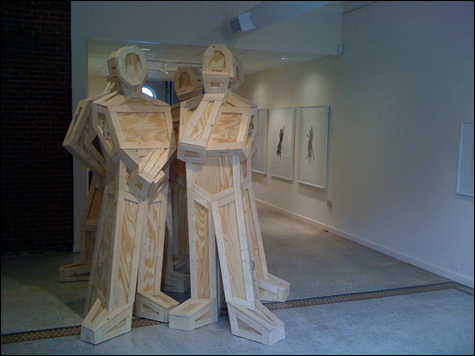
‘VESSELS ABSENT’ Statues by Aaron T. Stephan. |
Like a sort of late-winter Frankenstein, Aucocisco's "Corporeal" exhibition is assembled from work both new and old from two distinct artists in their prime, each offering a grand centerpiece and detailed thematic series in a thoughtful investigation of the artistic body.
Local sculptor Aaron T. Stephan has built a reputation from his adventurous figurative installations. Here, his work is pulled from his 2009 exhibition at the University of Maine Museum of Art in Bangor, and from "Taken Out of Context," an installation at Whitney Art Works the same year to create the magnificent focal point of the show: "Vessels Absent," a series of eight-foot-tall, three-dimensional statues assembled from crates of plywood, planks, and furring strips. Stephan's five structures stand at the center of the gallery in a circle, assuming incredibly realistic poses, appearing as humble giants containing human forms within their hollows.
Most impressive is the way Stephan has rendered the figures to compose the limbs of each structure, in smaller, protuberant crates that bulge over each body's core. Though subtle and gentle, the limbs are the most active ingredient in each figure, and their differences (one seems to have its hands in its back pocket, another covering its mouth, another pondering) bring "Vessels Absent" to life.
Another series from Stephan hangs on the gallery's broadside wall. In it, nine ink-on-paper drawings depict multiple iterations of Stephan's sketch of an iconic painting (Vermeer's "The Girl with a Pearl Earring") in varying twisted and folded patterns. The sketches are drawn in repetition in long strips, suggesting a photo-booth quality that may be a comment either on artistic mass production or the inescapable anxiety of influence.
Stephan's contributions are heavy on metaphor, difference, and repetition; given the show's theme, they offer some distinct conceptual puns. His statues immediately invoke both the Trojan horse (about as foundational an example of corporeal art as there is) and the three wise monkeys of Japanese folk faith (who cover eyes, ears, and mouth, respectively) — while his ink works appear to play with the ubiquity of the body of work of Vermeer.
Borrowing from past work of her own, Katherine Bradford's "Woman Flying" was originally featured in the 2001 Portland Museum of Art Biennial. As her centerpiece, it's an arresting work; an 80-by-68-inch oil on dropcloth canvas painting hanging on the wall near the gallery entrance. But despite its magnificent title, "Woman Flying" isn't exactly a celebration. The crude contours of a woman with a red cape hover over an open space, more awkwardly suspended than graceful. Her outstretched arms suggest yearning and desire, but her featureless face and body indicate a limit to her expectation.
At least that's how it appears in this show. Unlike its appearance in the PMA, "Flying Woman" serves as a conceptual launch pad for Bradford's other inclusions here. Nine more recent works in "Corporeal" offer reprisals of the figure, presenting her in a multitude of contexts and lending her the sense of animation not present in the original painting. Bradford's "Flying Woman Series," a collection of eight gouache, collage, and colored-pencil works (11 by 15 inches) from 2009, depict the flying woman in small stamps, as if the image has become the artist's logo or signature. In "Red Dots," the woman has conquered her dormancy, leaving a web of streaks behind her over a blue gouache field. "Air Stream" collects a collage of materials near the figure's head, as she hovers more comfortably over a textured pink background. "Paper" realizes the woman's faerie characteristics.